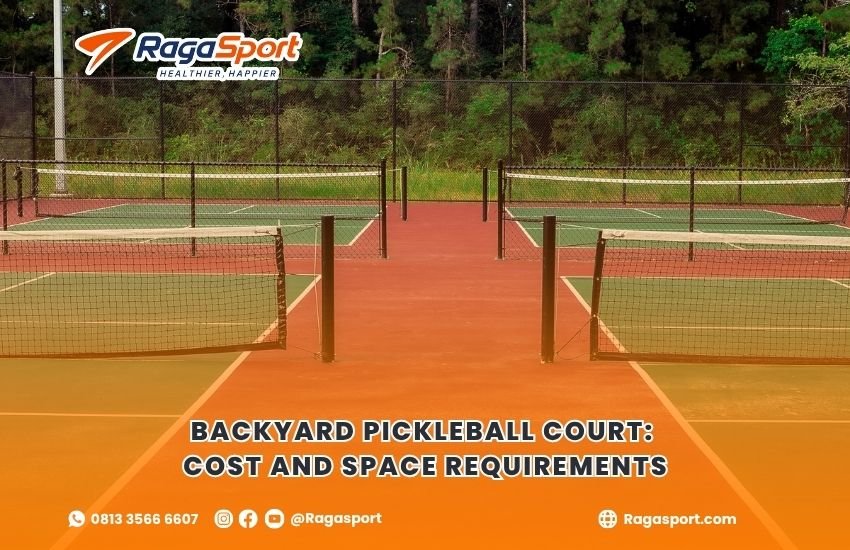Backyard Pickleball Court: Cost and Space Requirements
Imagine stepping out your back door into your very own pickleball court no need to drive, book time slots, or wait in line. This dream is becoming a reality for many homeowners who value fitness, fun, and property upgrades. Pickleball’s popularity is booming, and with its compact court size, it’s easier than ever to build a court right at home.
But before you pick up a paddle, there are two major questions to answer: Do you have enough space? and What will it cost? This guide breaks it down clearly, so you can make smart decisions before breaking ground.
Table of Contents
1. Backyard Pickleball Court: How Much Space Do You Need?
Pickleball isn’t as space-hungry as tennis, which makes it perfect for residential areas. The standard court dimensions are:
- Playing surface: 20 ft wide × 44 ft long (6.1 m × 13.4 m)
- Minimum total area recommended: 30 ft × 60 ft (9.1 m × 18.3 m)
That extra room around the court gives players space to move safely. If your backyard is slightly smaller, you can consider a half-court setup or even a multi-sport space with blended lines.
2. Is Your Backyard Court-Ready?
Having the space is one thing—but is your yard ready for construction? A great backyard pickleball court starts with:
- A flat and level area free from large tree roots or slopes
- Easy access for construction equipment
- Good drainage or the ability to install one
- Local permits, if required, especially for fencing or lights
Not sure? A site visit from a contractor can help assess your yard’s potential before you invest.
3. What Does It Cost to Build a Backyard Pickleball Court?
The investment varies depending on your choices. Here’s a breakdown of average costs in Indonesia for a standard single court:
Site Preparation – IDR 15–50 million
Includes clearing, leveling, compaction, and basic base layer (gravel or concrete prep).
Surface Installation – IDR 80–150 million
Choose from:
- Acrylic over concrete: Most durable and professional feel
- Modular court tiles: Easy to install, flexible, and colorful
- Asphalt with coating: Budget-friendly but less durable long-term
Net System and Posts – IDR 10–25 million
Includes tournament-quality nets, poles, and anchors. Optional: portable nets for shared-use areas.
Line Marking & Custom Paint – IDR 5–10 million
Professional court striping with anti-slip paint, available in standard or custom colors.
Lighting (Optional) – IDR 15–30 million
Ideal for evening play and maximizing use. LED lights are energy-efficient and weather-resistant.
Total Estimated Cost:
✅ IDR 150–300 million depending on surface, design, and add-ons.
4. How to Keep Costs Under Control

You don’t need a huge budget to get started. Here are ways to trim expenses without cutting corners:
- Use existing concrete pads, like old tennis or basketball courts
- Start with a basic setup, then upgrade later
- Choose modular surfaces for faster installation and lower maintenance
- DIY accessories like benches, ball baskets, or court windscreens
By working with an experienced builder, you can get creative without compromising quality.
5. Choosing the Right Surface: What Works Best?
Not all surfaces are equal. Here’s a quick comparison:
| Surface Type | Pros | Ideal For |
|---|---|---|
| Acrylic over Concrete | Long lifespan, smooth play | Permanent courts |
| Modular Tiles | Easy maintenance, bright colors | Multi-use or DIY setups |
| Asphalt | Lower cost, fast install | Budget-sensitive builds |
Your environment matters too—modular tiles may suit wet or shaded areas, while acrylic shines in open, sunny spaces.
6. Permits, Neighbors, and Legal Tips
Before starting, always check:
- Zoning regulations in your area
- Boundary rules—keep a safe distance from fences or buildings
- Noise ordinances, especially if installing lighting
- HOA approvals, if you live in a residential complex
Working with a licensed contractor helps ensure compliance and avoids headaches down the line.
7. Maintenance: How to Keep It Looking Great
With proper materials, a backyard pickleball court requires minimal effort:
- Sweep regularly to prevent buildup
- Hose down after heavy use or storms
- Repaint lines every few years
- Inspect tiles or surface coating yearly
Modular courts may allow easy tile replacement, while acrylic courts only need recoating every 5–7 years.
8. Why Hire a Professional?
While DIY may be tempting, hiring a pro ensures:
- Accurate court layout
- Proper drainage and slope handling
- Durable materials and finishing
- Warranties and post-installation support
A trusted contractor can design the court to suit your lifestyle and backyard dimensions perfectly.

Ready to Build the Perfect Backyard Pickleball Court?
Let Raga Sport turn your vision into reality with expert construction, top-quality materials, and a field that meets every standard.
👉 Explore our projects at ragasport.com
📲 Chat with our team now via WhatsApp: Click Here

